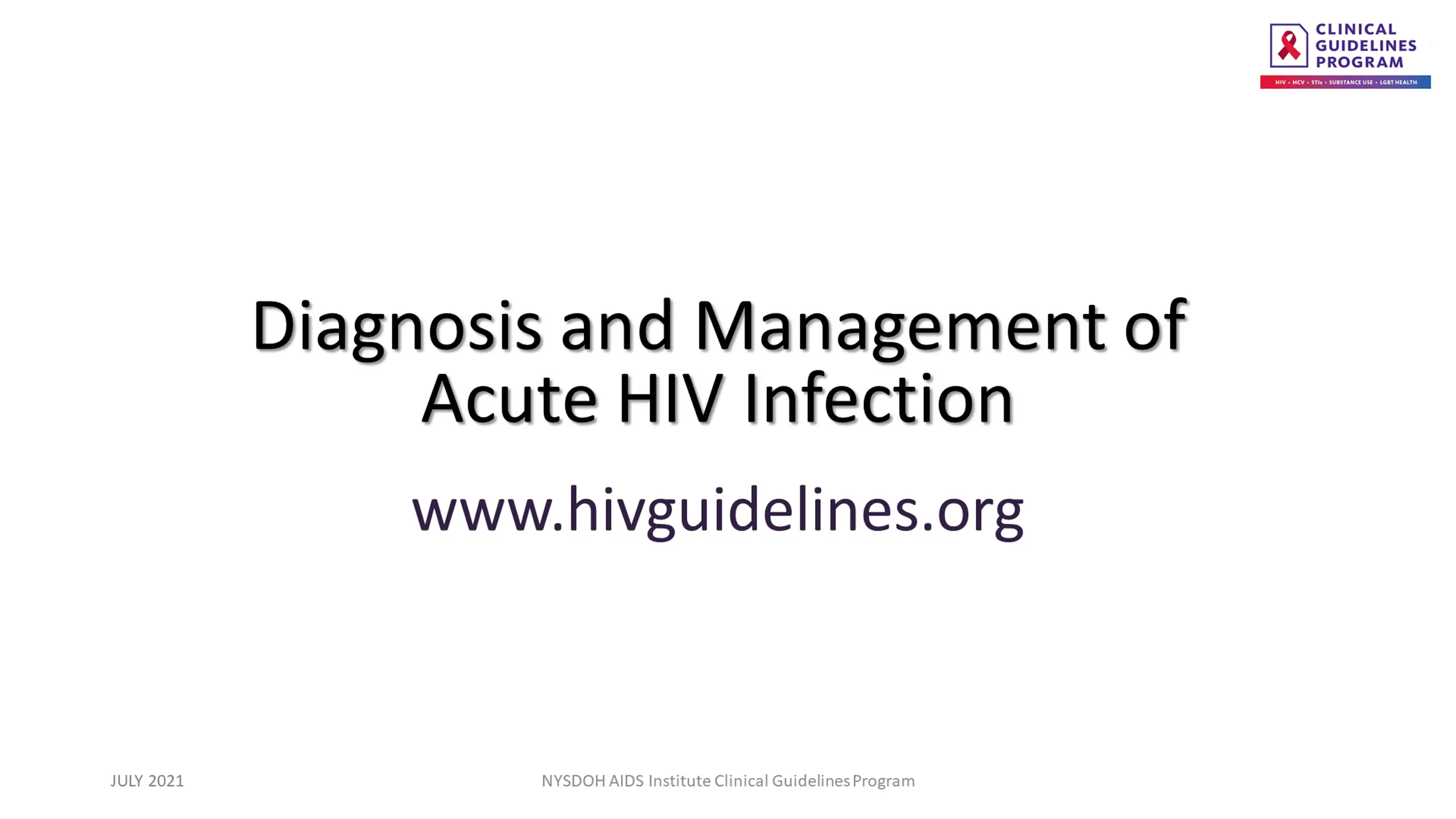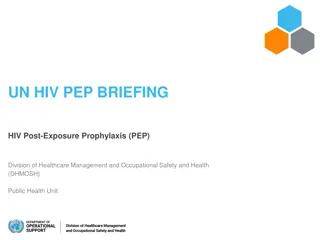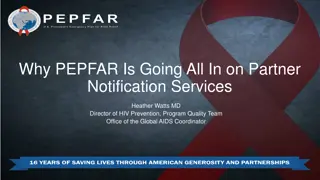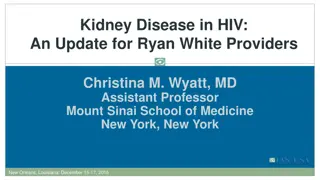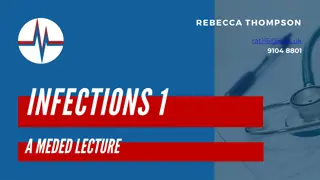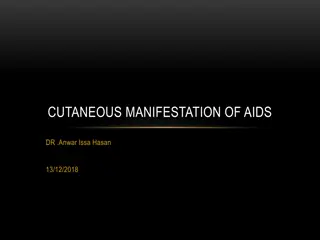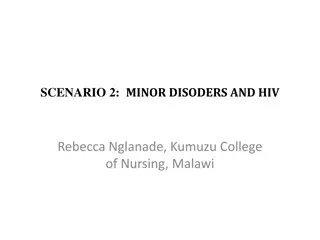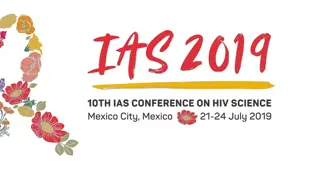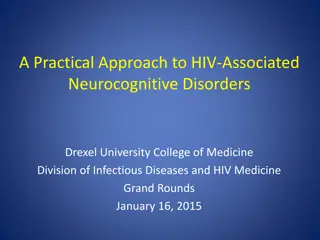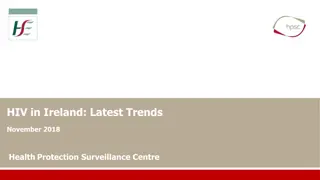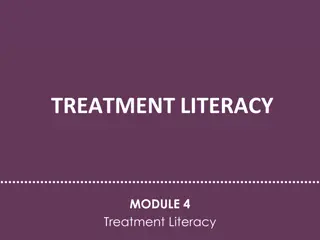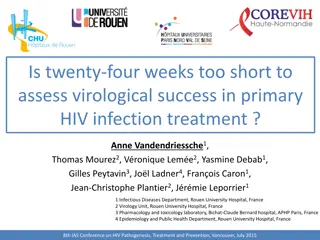Diagnosis and Management of Acute HIV Infection
Guideline aims to recognize the risks, signs, and symptoms of acute HIV infection and to promote HIV testing in individuals presenting with flu-like symptoms or viral syndromes. It provides recommendations for diagnostic testing, treatment, and prevention services to improve patient health and reduce HIV transmission.
Download Presentation

Please find below an Image/Link to download the presentation.
The content on the website is provided AS IS for your information and personal use only. It may not be sold, licensed, or shared on other websites without obtaining consent from the author.If you encounter any issues during the download, it is possible that the publisher has removed the file from their server.
You are allowed to download the files provided on this website for personal or commercial use, subject to the condition that they are used lawfully. All files are the property of their respective owners.
The content on the website is provided AS IS for your information and personal use only. It may not be sold, licensed, or shared on other websites without obtaining consent from the author.
E N D
Presentation Transcript
Diagnosis and Management of Acute HIV Infection www.hivguidelines.org JULY 2021 NYSDOH AIDS Institute Clinical Guidelines Program
Purpose of This Guideline Purpose of This Guideline Recognize the risks for and signs and symptoms of acute HIV, include HIV infection in the differential diagnosis, and consider HIV testing in any person who presents with signs and symptoms suggestive of influenza ( flu ), mononucleosis ( mono ), or other viral syndromes, including suspected COVID-19. Perform appropriate diagnostic and confirmatory testing when HIV infection is suspected and manage the treatment of acute HIV. Meet the NYS requirements for reporting and partner notification. Recommend or offer immediate initiation of ART to improve the patient s health and reduce the risk of HIV transmission; refer and confirm that patients can access optimal HIV care. Initiate or refer the patient for prevention services. JULY 2021 NYSDOH AIDS Institute Clinical Guidelines Program www.hivguidelines.org
Terminology Terminology Acute HIV infection: Describes the period immediately after infection with HIV when an individual is viremic and has detectable p24 antigen or has HIV RNA without diagnostic HIV antibodies. In the medical literature, primary HIV infection may describe this same period. Recent infection: Generally used to describe the 6-month period after infection occurs. Early infection: May refer to acute or recent infection, after which infection is defined as chronic. JULY 2021 NYSDOH AIDS Institute Clinical Guidelines Program www.hivguidelines.org
Key Points Key Points HIV is highly transmissible during acute infection; rapid initiation of ART reduces transmission, with significant public health benefits, and early viral suppression preserves immune function, with significant clinical benefits for the individual with HIV. Acute HIV often has nonspecific signs and symptoms and often goes unsuspected and undetected. This committee urges a high index of suspicion for acute infection and HIV testing for any individual who reports recent high-risk behavior or presents with signs or symptoms of influenza, mononucleosis, or other viral syndromes. When HIV infection is diagnosed, immediate linkage to care is essential; ART dramatically reduces HIV- related morbidity and mortality, and viral suppression prevents HIV transmission. The urgency of ART initiation is even greater if the newly diagnosed patient is pregnant, has acute HIV infection, is 50 years old, or has advanced disease. For these patients, every effort should be made to initiate ART immediately, ideally on the same day as diagnosis. All clinical care settings should be prepared, either on-site or with a confirmed referral, to support patients in initiating ART as rapidly as possible after diagnosis. When a diagnosis of acute HIV infection is made, clinicians should discuss the importance of notifying all recent contacts and refer patients to partner notification services, as mandated by NYS law. The NYSDOH can provide assistance if necessary. JULY 2021 NYSDOH AIDS Institute Clinical Guidelines Program www.hivguidelines.org
New York State Law New York State Law Clinicians must perform diagnostic HIV laboratory tests in full compliance with NYS HIV/AIDS Laws and Regulations. Clinicians must report confirmed cases of HIV according to NYS law (see NYSDOH Provider Reporting and Partner Services). Additional information regarding testing procedures and regulations is available from the NYSDOH Wadsworth Center (518-474-2163). Consent: In November 2016, amendments to NYS public health law removed the requirement for written or oral informed consent before an HIV test is ordered; see HIV Testing, Reporting and Confidentiality in New York State 2017-18 Update: Fact Sheet and Frequently Asked Questions. JULY 2021 NYSDOH AIDS Institute Clinical Guidelines Program www.hivguidelines.org
Recommendations: Recommendations: NYS HIV Testing Requirements & Partner Notification NYS HIV Testing Requirements & Partner Notification According to NYS law, physicians must offer an HIV test to all patients aged 13 years and older (or younger with risk) if a previous test is not documented, even in the absence of symptoms consistent with acute HIV. Although written consent to HIV testing is no longer required in NYS, patients must be given the opportunity to decline, and verbal consent must be documented in the medical record. Clinicians should offer assistance with partner notification and refer patients to other sources for partner notification assistance (NYSDOH What Health Care Providers Need to Know about Partner Services or NYC Contact Notification Assistance Program). (A2) JULY 2021 NYSDOH AIDS Institute Clinical Guidelines Program www.hivguidelines.org
Recommendations: Recommendations: Presentation Presentation Clinicians should include acute HIV infection in the differential diagnosis for anyone (regardless of reported risk) who presents with signs or symptoms of influenza ( flu ), mononucleosis ( mono ), or other viral syndromes (A3), especially when the patient: Presents with a rash. (A2) Requests HIV testing. (A3) Reports recent sexual or parenteral exposure to a person with or at risk of HIV infection. (A2) Presents with a newly diagnosed STI. (A2) Presents with aseptic meningitis. (A2) Is pregnant or breastfeeding. (A3) Is currently taking antiretroviral medications for PrEP or PEP. (A3) Diagnostic HIV RNA testing should be considered for patients who present with compatible symptoms (see Acute Retroviral Syndrome), particularly in the presence of an STI or a recent sexual or parenteral exposure with a partner known to have HIV or with unknown HIV serostatus. (A2) JULY 2021 NYSDOH AIDS Institute Clinical Guidelines Program www.hivguidelines.org
HIV Test Window HIV Test Window of Detection of Detection Notes: a.Figure reproduced from CDC: HIV Diagnostic Test. b.Without PrEP or PEP exposure; PrEP or PEP exposure may delay seroconversion. Very early treatment of acute HIV infection may also alter the serologic response. JULY 2021 NYSDOH AIDS Institute Clinical Guidelines Program www.hivguidelines.org
Acute Retroviral Syndrome Acute Retroviral Syndrome Signs and symptoms of ARS with the expected frequency among symptomatic patients: Fever (80%) Tired or fatigued (78%) Malaise (68%) Arthralgias (joint pain) (54%) Headache (54%) Loss of appetite (54%) Rash (51%) Night sweats (51%) Myalgias (pain in muscles) (49%) Nausea (49%) Diarrhea (46%) Fever and rash (46%) Pharyngitis (sore throat) (44%) Oral ulcers (mouth sores) (37%) Weight loss (>5 lb; 2.5 kg) (32%) Confusion (25%) Photophobia (24%) Vomiting (12%) Infected gums (10%) Sores on anus (5%) JULY 2021 NYSDOH AIDS Institute Clinical Guidelines Program www.hivguidelines.org
Recommendations: Recommendations: When Acute HIV Infection is Suspected When Acute HIV Infection is Suspected Clinicians should always perform a plasma HIV RNA assay in conjunction with an Ag/Ab combination immunoassay screening test. (A2) Clinicians should use an Ag/Ab combination immunoassay (preferred) as the initial HIV screening test according to the standard HIV laboratory testing algorithm. If the screening test is reactive, clinicians should perform an HIV-1/HIV- 2 Ab differentiation immunoassay to confirm HIV infection. (A1) Note: When rapid Ab screening is performed, even with a rapid Ag/Ab combination immunoassay, a laboratory-based Ag/Ab combination immunoassay is recommended for follow-up diagnostic HIV testing. JULY 2021 NYSDOH AIDS Institute Clinical Guidelines Program www.hivguidelines.org
Recommendations: Recommendations: Diagnosis Diagnosis Clinicians can presume the diagnosis of acute HIV when high levels (>10,000 copies/mL) of HIV RNA are detected in plasma with sensitive NAT, and the result of the HIV screening or type-differentiation test is negative or indeterminate. (A2) When a low-level quantitative HIV RNA viral load result (<10,000 copies/mL) is obtained in the absence of serologic evidence of HIV infection, the clinician should repeat HIV RNA testing and perform an Ag/Ab combination immunoassay to exclude a false-positive result. (A2) Note: A serologic test result that does not meet the criteria for HIV infection is a nonreactive screening result (Ab or Ag/Ab combination) or a reactive screening result with a nonreactive or indeterminate Ab differentiation confirmatory result. Clinicians should seek expert consultation when an ambiguous HIV result is obtained for an individual taking PrEP because the diagnosis of acute HIV can be particularly challenging in patients taking PrEP. (A3) See the NYSDOH AI guideline PrEP to Prevent HIV and Promote Sexual Health > Suspected Acute HIV. JULY 2021 NYSDOH AIDS Institute Clinical Guidelines Program www.hivguidelines.org
Diagnostic Testing for Acute HIV Infection Diagnostic Testing for Acute HIV Infection JULY 2021 NYSDOH AIDS Institute Clinical Guidelines Program www.hivguidelines.org
Key Points: Key Points: Diagnosis Diagnosis The diagnosis of acute HIV infection requires a high degree of clinical awareness. The nonspecific signs and symptoms of acute HIV infection are often not recognized or attributed to another viral illness. Diagnostic HIV RNA testing should be considered for all patients who present with compatible symptoms (see signs and symptoms of ARS), particularly in the context of a sexually transmitted infection or a recent sexual or parenteral exposure with a partner known to have HIV or a partner whose HIV serostatus is not known. Individual laboratories have internal protocols for reporting HIV tests with preliminary results. The terms used when preliminary results cannot be classified include indeterminate, inconclusive, nondiagnostic, and pending validation. Clinicians can contact the appropriate laboratory authority to determine the significance of nondefinitive results and the recommended supplemental testing, particularly when acute HIV infection is suspected. Clinicians are advised to become familiar with the internal test-reporting policies of their institutions. JULY 2021 NYSDOH AIDS Institute Clinical Guidelines Program www.hivguidelines.org
Recommendations: Recommendations: ART Initiation ART Initiation If a diagnosis of acute infection is made based on HIV RNA testing, clinicians should recommend ART initiation without waiting for serologic confirmation. (A2) See the NYSDOH AI guideline Rapid ART Initiation. When a pregnant individual is diagnosed with acute infection by HIV RNA testing, the clinician should not wait for the result of a confirmatory test to initiate ART; initiation of ART is strongly recommended for pregnant patients. (A2) See the NYSDOH AI guideline HIV Testing During Pregnancy, at Delivery, and Postpartum. JULY 2021 NYSDOH AIDS Institute Clinical Guidelines Program www.hivguidelines.org
Recommendations: Recommendations: Managing Acute HIV Managing Acute HIV Clinicians should recommend ART to all patients diagnosed with acute HIV infection. (A1) Clinicians should inform patients about the increased risk of transmitting HIV during acute infection and for the 6 months following infection in patients who do not initiate ART. (A2) As part of the initial management of patients diagnosed with acute HIV infection, clinicians should: Consult with a care provider experienced in the treatment of acute HIV infection. (A3) Obtain HIV genotypic resistance testing for the protease (A2), reverse transcriptase (A2), and integrase (B2) genes at the time of diagnosis. Patients taking PEP: When acute HIV infection is diagnosed in an individual receiving PEP, ART should be continued pending consultation with an experienced HIV care provider. (A3) Patients taking PrEP: Because the risk of drug-resistant mutations is higher in patients who acquire HIV while taking PrEP, clinicians should consult with an experienced HIV care provider and recommend a fully active ART regimen. (A3) See the NYSDOH AI guideline PrEP to Prevent HIV and Promote Sexual Health > Managing a Positive HIV Test Result. Clinicians who do not have access to experienced HIV care providersshould call the Clinical Education Initiative (CEI) Line at 866-637-2342. JULY 2021 NYSDOH AIDS Institute Clinical Guidelines Program www.hivguidelines.org
Recommendations: Recommendations: Initiating ART Initiating ART When a patient agrees with the clinician s recommendation to initiate ART during acute HIV infection: The clinicians should implement treatment to suppress the patient s plasma HIV RNA to below detectable levels. (A1) Clinicians should perform baseline laboratory testing listed in Baseline Laboratory Testing Checklist for all patients initiating ART immediately; ART can be started while awaiting laboratory test results. (A3) JULY 2021 NYSDOH AIDS Institute Clinical Guidelines Program www.hivguidelines.org
Baseline Laboratory Testing Checklist Baseline Laboratory Testing Checklist HIV-1/2 antigen/antibody assay HIV quantitative viral load Baseline HIV genotypic resistance profile Baseline CD4 cell count Testing for hepatitis A, B, and C viruses Comprehensive metabolic panel (creatinine clearance, hepatic profile) See CDC > Sexually Transmitted Infections Treatment Guidelines, 2021 > Screening Urinalysis Pregnancy test for individuals of childbearing potential JULY 2021 NYSDOH AIDS Institute Clinical Guidelines Program www.hivguidelines.org
Need Help? Need Help? NYSDOH AIDS Institute Clinical Guidelines Program www.hivguidelines.org
Access the Guideline Access the Guideline www.hivguidelines.org > Diagnosis and Management of Acute HIV Infection Also available: Printable pocket guide and PDF NYSDOH AIDS Institute Clinical Guidelines Program www.hivguidelines.org
